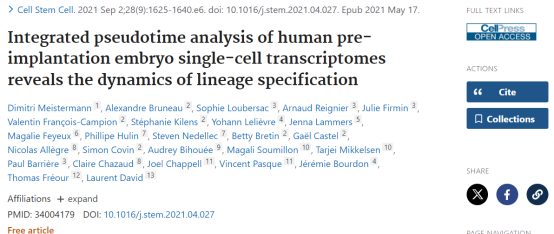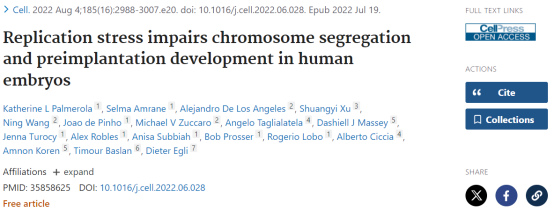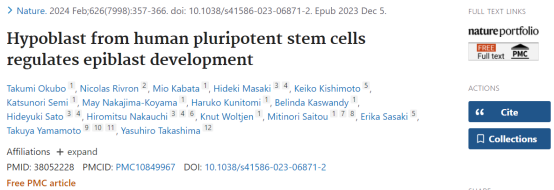
1.Modeling post-implantation stages of human development into early organogenesis with stem-cell-derived peri-gastruloids

https://www.cell.com/cell/abstract/S0092-8674(23)00794-8
DOI: 10.1016/j.cell.2023.07.018
The article discusses a new method for creating embryo-like structures called peri-gastruloids from human extended pluripotent stem cells. These structures include both embryonic and extraembryonic tissues and replicate key stages of early human development, such as forming cavities, developing embryonic discs, and initiating organogenesis. Although not viable due to the absence of certain cells, peri-gastruloids resemble natural human peri-gastrulation development. Single-cell RNA-sequencing confirms their similarity to natural cell types. This new platform could facilitate research beyond gastrulation and potentially aid in regenerative medicine by developing human fetal tissues.
2.Integrated pseudotime analysis of human pre-implantation embryo single-cell transcriptomes reveals the dynamics of lineage specification

https://www.cell.com/cell-stem-cell/fulltext/S1934-5909(21)00185-5
DOI: 10.1016/j.stem.2021.04.027
This passage discusses the importance of understanding lineage specification in human pre-implantation development for enhancing assisted reproductive technologies and stem cell research. The study utilizes pseudotime analysis of single-cell RNA sequencing data to reconstruct early mouse and human embryo development. By integrating time-lapse imaging of annotated embryos, the study offers a comprehensive analysis of transcriptomic changes throughout human development. Key findings include the divergence of human trophectoderm/inner cell mass transcriptomes at the B2 to B3 blastocyst stage, the dynamics of fate markers IFI16 and GATA4, and the role of NR2F2 in trophectoderm maturation. Overall, the study identifies the precise timing of lineage specification events and transcriptomic hallmarks in human embryos.
3.Replication stress impairs chromosome segregation and preimplantation development in human embryos

https://www.sciencedirect.com/science/article/pii/S0092867422007802
DOI: 10.1016/j.cell.2022.06.028
This article explores how human cleavage-stage embryos often develop chromosomal abnormalities during mitosis, but the underlying mechanisms are unclear. The study demonstrates that during the S phase at the 1-cell stage, there is replication fork stalling and slow fork speed, leading to DNA synthesis extending into the G2 phase. This causes DNA damage, including collapsed replication forks and double-strand breaks, in a manner dependent on ATR and MRE11. Subsequently, spontaneous chromosome breakage and segmental aneuploidies occur. Entry into mitosis with incomplete replication leads to various chromosomal errors, micronucleation, fragmentation, and poor embryo quality. The sites of chromosome breakage coincide with DNA synthesis sites in G2 phase, particularly in gene-poor regions with long neural genes that are transcriptionally silent during this stage. Thus, DNA replication stress in early mammalian embryos, especially in humans, makes gene-poor regions fragile, increasing the likelihood of aneuploidies and impairing developmental potential.
4.Hypoblast from human pluripotent stem cells regulates epiblast development

https://www.nature.com/articles/s41586-023-06871-2
DOI: 10.1038/s41586-023-06871-2
The passage discusses the need to study human embryos due to differences from mice. However, ethical and legal restrictions limit post-implantation-stage studies. To overcome this, scientists have been working on developing in vitro models using human stem cells. The researchers report on their genetic and non-genetic approaches to create hypoblast cells from human pluripotent stem cells. These cells spontaneously combine with other stem cells to form a three-dimensional structure called bilaminoids, resembling the early stages of embryo development. By introducing analogues of the second extraembryonic tissue, the efficiency of bilaminoid formation increases. The bilaminoids accurately mimic the pattern and formation of cells during early embryogenesis. The study successfully models and identifies the mechanisms involved in guiding the growth and progression of the epiblast during post-implantation development in humans.
5.Transcription of MERVL retrotransposons is required for preimplantation embryo development

https://www.nature.com/articles/s41588-023-01324-y
DOI: 10.1038/s41588-023-01324-y
The study highlights the importance of zygotic genome activation (ZGA) in embryo development and how the retrotransposon called MERVL is involved in this process in mice. MERVL is upregulated during ZGA and is used as a marker for totipotency. The study shows that full-length MERVL transcripts, rather than the encoded retroviral proteins, are crucial for regulating the host transcriptome and chromatin state during preimplantation development. Knockdown or repression of MERVL leads to embryonic lethality due to defects in differentiation and genomic stability. Analysis of the transcriptome and epigenome reveals that the absence of MERVL transcripts results in abnormal expression of two-cell-specific genes and retention of an accessible chromatin state. These findings suggest that an endogenous retrovirus like MERVL plays a critical role in determining cell fate potential in the host embryo.






Post comments